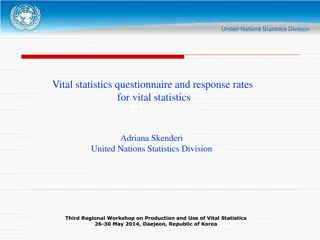Understanding Basic Statistics in Research and Evidence-Based Practice
Basic statistics play a crucial role in research and evidence-based practice. Descriptive statistics help summarize data, while inferential statistics make inferences about populations based on samples. Various types of statistics like hypothesis testing, correlation, confidence intervals, and significance testing are used to analyze data. Descriptive statistics can be used to summarize variables by looking at frequencies, percentages, means, and standard deviations. Different ways to display frequencies and percentages for ordinal and interval/ratio data are also explained. Measures of central tendency (mean, median, mode) and dispersion (variance, standard deviation) are computed for interval/ratio data to understand data spread and outliers.
- Basic Statistics
- Research Methods
- Evidence-Based Practice
- Descriptive Statistics
- Inferential Statistics
Download Presentation

Please find below an Image/Link to download the presentation.
The content on the website is provided AS IS for your information and personal use only. It may not be sold, licensed, or shared on other websites without obtaining consent from the author. Download presentation by click this link. If you encounter any issues during the download, it is possible that the publisher has removed the file from their server.
E N D
Presentation Transcript
NURS 790: Methods for Research and Evidence Based Practice BASIC STATISTICS OVERVIEW
Types of Statistics/Analyses DESCRIPTIVE STATISTICS INFERENTIAL STATISTICS Hypothesis Testing Correlation Confidence Intervals Significance Testing Prediction Inferential statistics make Inferences about a phenomena Proving or disproving theories Associations between phenomena If sample relates to the larger population E.g., Diet and health Frequencies Basic measurements Descriptive Statistics describe a phenomena How many? How much? BP, HR, BMI, IQ, etc.
Descriptive Statistics Descriptive statistics can be used to summarize and describe a single variable Frequencies (counts) & Percentages Use with categorical (nominal) data Levels, types, groupings, yes/no, Drug A vs. Drug B Means & Standard Deviations Use with continuous (interval/ratio) data Height, weight, cholesterol, scores on a test
Frequencies & Percentages Look at the different ways we can display frequencies and percentages for this data:
Ordinal Level Data Frequencies and percentages can be computed for ordinal data Examples: Likert Scales (Strongly Disagree to Strongly Agree); High School/Some College/College Graduate/Graduate School 60 50 40 30 20 10 0 Strongly Agree Agree Disagree Strongly Disagree
Interval/Ratio Data We can compute frequencies and percentages for interval and ratio level data as well Examples: Age, Temperature, Height, Weight, Many Clinical Serum Levels
Interval & Ratio Data Measures of central tendency and measures of dispersion are often computed with interval/ratio data Measures of Central Tendency (aka, the Middle Point ) Mean, Median, Mode If your frequency distribution shows outliers, you might want to use the median instead of the mean Measures of Dispersion (aka, How spread out the data are) Variance, standard deviation, standard error of the mean Describe how spread out a distribution of scores is High numbers for variance and standard deviation may mean that scores are all over the place and do not necessarily fall close to the mean
INFERENTIAL STATISTICS Inferential statistics can be used to: prove or disprove theories, determine associations between variables, and determine if findings are significant and whether or not we can generalize from our sample to the entire population Common types of inferential statistics Correlation T-tests/ANOVA Chi-square Logistic Regression
Type of Data & Inferential Analysis Analysis of Categorical/Nominal Data Correlation T-tests T-tests Analysis of Continuous Data Chi-square Logistic Regression
Correlation When to use it? When you want to know about the association or relationship between two continuous variables Ex) food intake and weight; drug dosage and blood pressure; air temperature and metabolic rate, etc. What does it tell you? If a linear relationship exists between two variables, and how strong that relationship is What do the results look like? The correlation coefficient = Pearson s r Ranges from -1 to +1
Correlation How do you interpret it? If r is positive, high values of one variable are associated with high values of the other variable (both go in SAME direction - OR ) Ex) Diastolic blood pressure tends to rise with age, thus the two variables are positively correlated If r is negative, low values of one variable are associated with high values of the other variable (opposite direction - OR ) Ex) Heart rate tends to be lower in persons who exercise frequently, the two variables correlate negatively Correlation of 0 indicates NO linear relationship How do you report it? Diastolic blood pressure was positively correlated with age (r = .75, p < . 05).
T-tests When to use them? Paired t-tests: When comparing the MEANS of a continuous variable in two non-independent samples (i.e., measurements on the same people before and after a treatment) Ex) Is diet X effective in lowering serum cholesterol levels in a sample of 12 people? Ex) Do patients who receive drug X have lower blood pressure after treatment then they did before treatment? Independent samples t-tests: To compare the MEANS of a continuous variable in TWO independent samples (i.e., two different groups of people) Ex) Do people with diabetes have the same Systolic Blood Pressure as people without diabetes?
T-tests What does a t-test tell you? If there is a statistically significant difference between the mean score (or value) of two groups (either the same group of people before and after or two different groups of people) What do the results look like? Student s t How do you interpret it? By looking at corresponding p-value If p < .05, means are significantly different from each other If p > 0.05, means are not significantly different from each other
Chi-square When to use it? When you want to know if there is an association between two categorical (nominal) variables (i.e., between an exposure and outcome) Ex) Smoking (yes/no) and lung cancer (yes/no) Ex) Obesity (yes/no) and diabetes (yes/no) What does a chi-square test tell you? If the observed frequencies of occurrence in each group are significantly different from expected frequencies (i.e., a difference of proportions)
Chi-square What do the results look like? Chi-square test statistics = X2 How do you interpret it? Usually, the higher the chi-square statistic, the greater likelihood the finding is significant, but you must look at the corresponding p-value to determine significance























